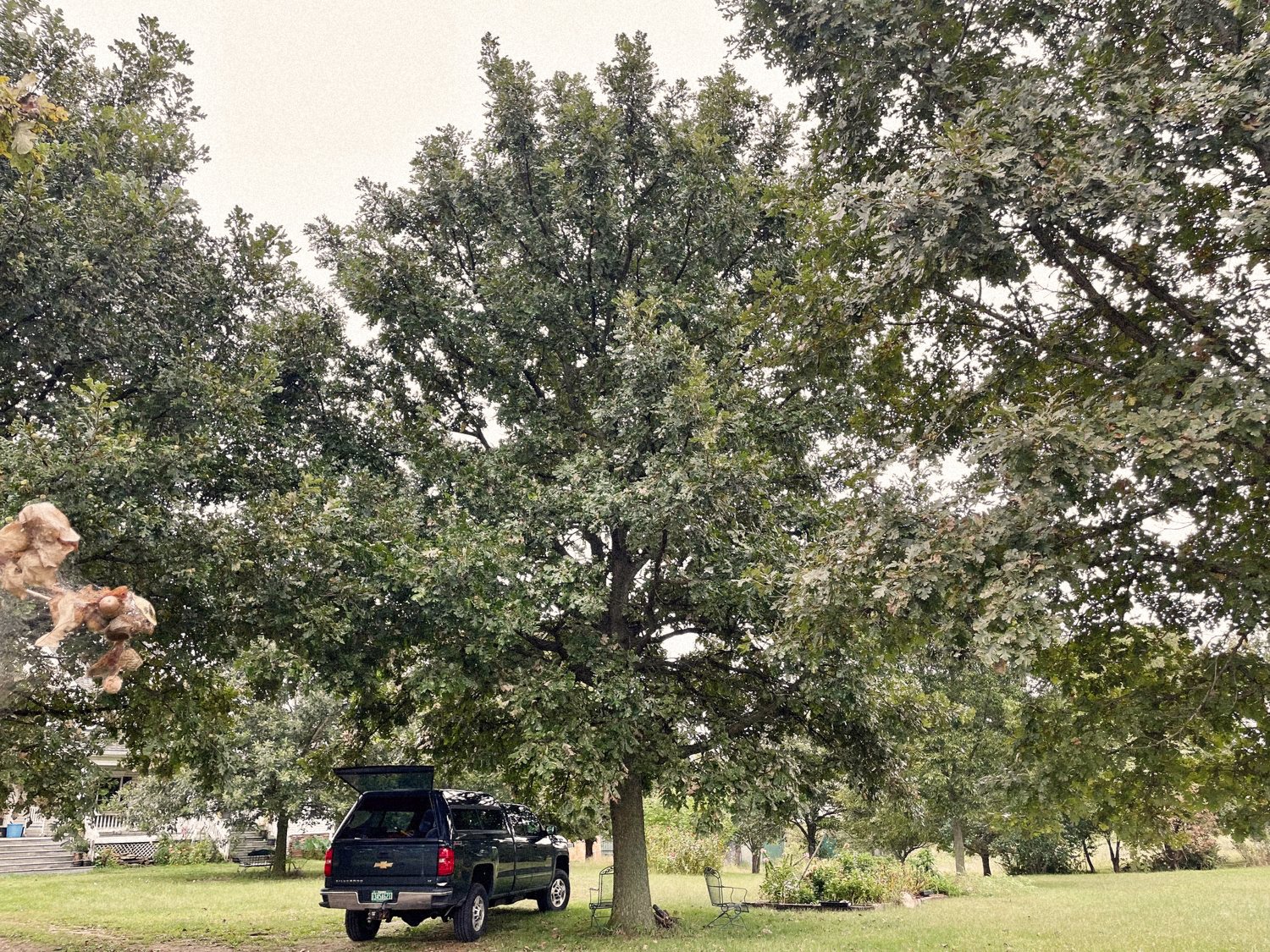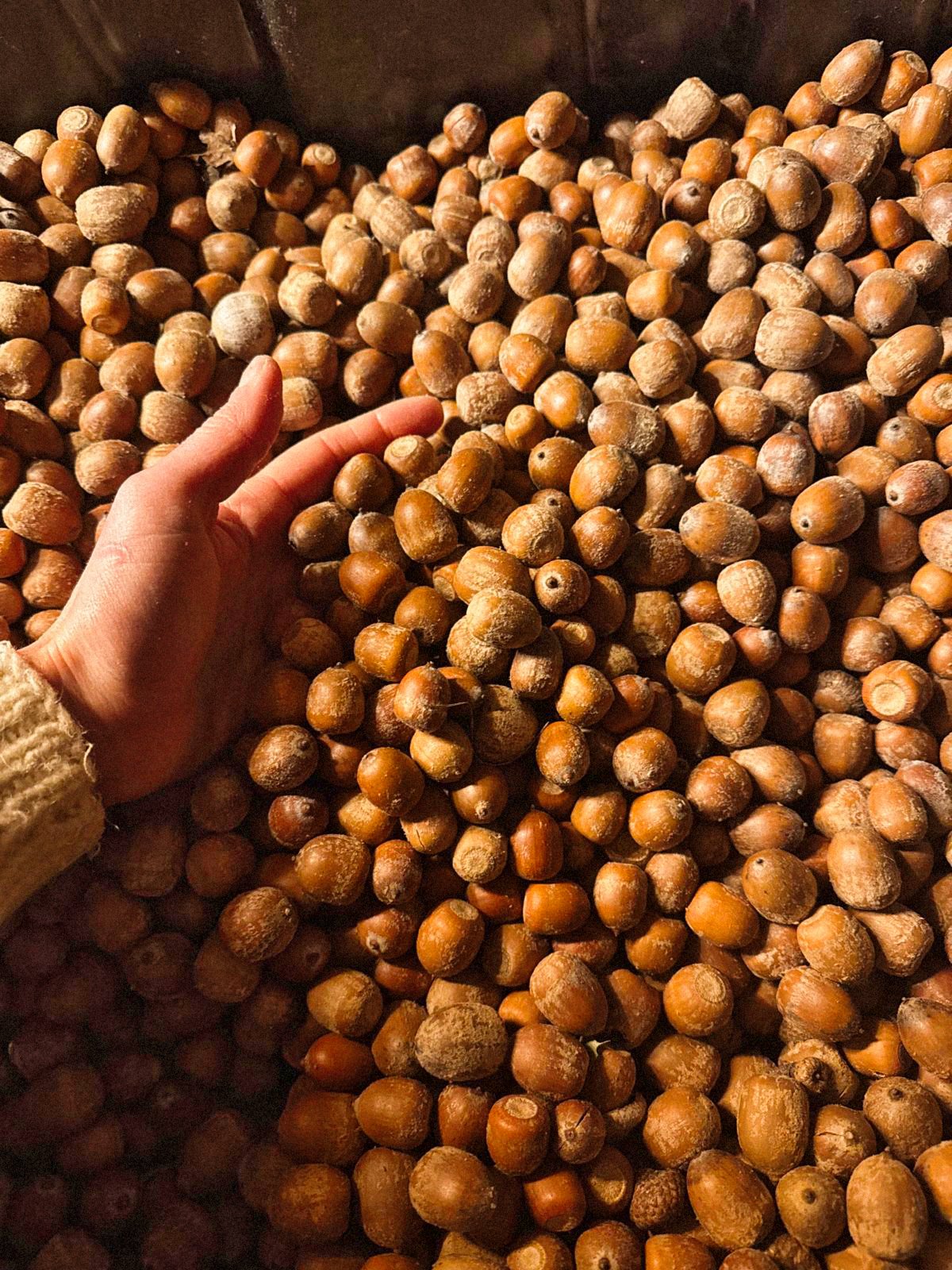Acorn Flour & Oil
(Credit: Yellowbud Farm)
(Credit: Dana Maple Feeney)
North America’s native oak population holds the potential to create viable industry around acorn flour and acorn oil. Based on analysis of the literature, the observations of nursery-people across the country, and our own observations of the native oaks in the Northeast, we and our partners believe commercially-viable genetics may be nearer at hand than many suspect. Acorn crop development has the potential for transformative impact:
+ Ecological Value
Oak, hickory, and chestnut were keystone species in the woodland ecologies of precolonial North America, and it is no coincidence they were also keystone foods for many native peoples. There is abundant evidence that native peoples of North America pruned and tended their landscapes to select for these species — both as versatile, storage-friendly staple calories and as fodder for game animals.
Today, oak remains a keystone species of singular importance to the ecologies they inhabit. Of all plant genera in the Eastern Woodlands, oak is the single most “generous” — offering food and habitat to more birds, bugs, and other wildlife than any other member of our living community. Thus, incorporating oaks into agricultural landscapes offers big opportunities to enhance wildlife habitat.
+ Food System Value
As a food, acorn falls on a spectrum between chestnut (mostly carbs, some fat and protein) and hickory or walnut (mostly fat, some carbs and protein). Acorns generally offer a balanced profile of carbs and fat, with some protein. Many acorns are well suited to be dried and ground into flour, and some (more fatty) acorns are well suited to be pressed into oil.
The development of industry around acorn flour would offer the Northeast tremendous food security, as well as economic value. The global gluten free flour market size was valued at $6.4 billion in 2022, and is projected to reach $9.4 billion by 2031.
+ Agronomic Potential
Oak trees live for hundreds of years, and the top 10% of the population appears capable of producing enormous yields that should be more than sufficient for viable agriculture. Oaks have often been thought of as a less-promising tree crop due to the perception of slow growth rates, and the fact that acorns contain tannins that need to be leached to make them edible. But hybrid oaks mature much more quickly than most people realize — often bearing within 4-7 years. And removing tannins at an industrial post-harvest scale is much less laborious than doing so at a home scale. Active acorn food industries already exist in Spain, Portugal, and South Korea, offering templates for agronomics, harvest, and post-harvest processing.
Our early yield observations align with the scientific literature on forest-grown oaks. These observations suggest that managed, open-grown oaks can drastically outpace the yield curves of forest-grown oaks, and that 5-10% of the native oak population are “super producers”, which produce >50% of total acorns in any given stand. Breadtree has identified 2 parents (likely 50+ years old) that produce >300 lbs of acorns in a mast year, which suggest the potential for acorn orchards with a rolling average production equal to that of wheat, on a per-acre basis.
Research Questions
Chestnuts have only become commercially viable and scalable due to the germplasm and agronomic R&D done in the 20th century by generations of citizen scientists and breeders. Given comparable R&D, acorns (and hickories) could become important new orchard crops and forest products, with substantial positive impact on regional food security and ecological health.
Some key questions that need to be answered re: the agronomics of acorn production:
How quickly can different oak species (and hybrids) achieve acorn production in a well-managed silvopastoral setting?
Given that oak yields tend to naturally fluctuate in 3-5 year cycles, to what extent can yields be stabilized year-to-year?
Of those more stable yielding trees, which offer the largest rolling average of acorn production (as compared with peak annual production)? Given naturally cyclical fluctuations, “Yield” in the case of oaks is probably more effectively defined as the average acorn production across 5 years.
What are we (and our colleagues) doing about it?
(Credit: Yellowbud Farm)
Observing & propagating known superior genetics: Folks like Yellowbud Farm, Dispersion Farms, Perfect Circle Farm, Twisted Tree Farm and many others are collecting acorns and scion wood from noted well producing oak trees planted by previous generations of nut growers, and propagating the next generation from this plant material. These efforts make important genetics widely available to farmers interested in investing in acorn production.
Conducting harvest and post-harvest R&D: Sam Thayer’s “Nature’s Garden” documents the author’s deep experience and experimentation with harvesting and processing acorns into both flour and oil.
Conducting meta-analysis: Our friend and colleague Eric Toensmeier’s "The status of oak breeding and domestication as food for people and livestock" is a great primer on the topic of the development of acorn as a food in the U.S.
Identifying new genetics: Breadtree Farms has begun its own internal project to identify, observe, and select acorns from super-productive, unmanaged oaks around the Northeast.
Establishing breeding and production trials: In 2025-2028, with a consortium of partners, Breadtree Farms is conducting germplasm R&D and establishing ~15 acres of breeding orchards for native and hybrid oaks in both white and red groups, aimed at both flour and oil production. If this project is successful, it will yield a marketable crop of flour (and maybe oil), and a pool of excellent genetics from which many farmers could establish the next generation of acorn orchards.






